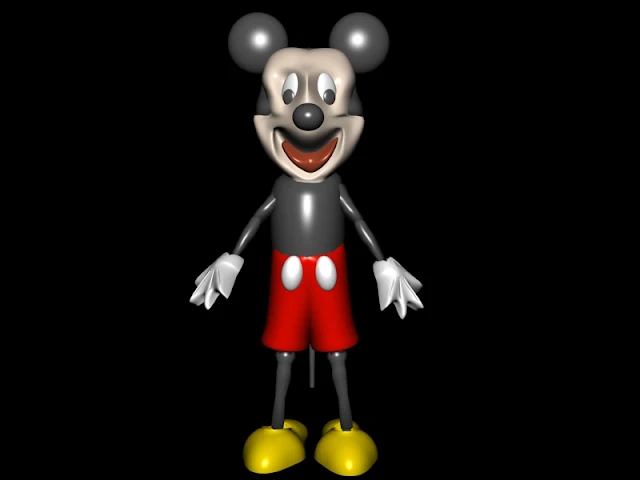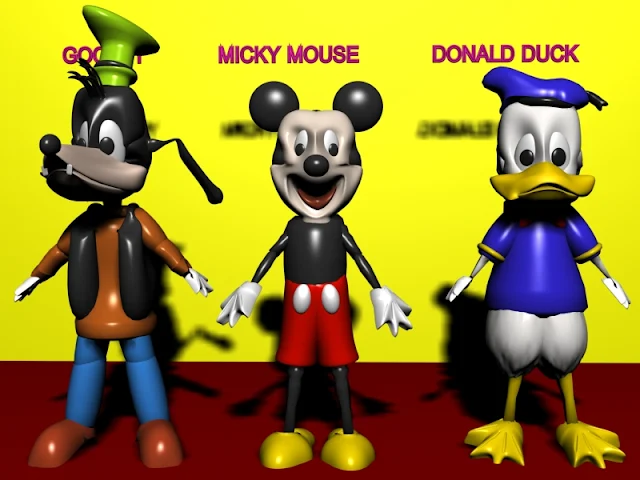born Dec. 5, 1901, Chicago, Ill., U.S.
died Dec. 15, 1966, Los Angeles, Calif.
U.S. animator and entertainment executive.
Photograph:Walt Disney, 1950.
Walt Disney, 1950.
 |
| Picture of Walt Disney in front of his famous creation Micky Mouse |
Animation:
Process of giving the illusion of movement to drawings, models, or inanimate objects.
From the mid-1850s, such optical devices as the zoetrope produced the illusion of animation. Stop-action photography enabled the production of cartoon films. The innovative design and assembly techniques of Walt Disney soon moved him to the forefront of the animation industry, and he produced a series of classic animated films, beginning with Snow White and the Seven Dwarfs (1937). The Fleischer brothers and the animators at Warner Brothers offered more irreverent cartoons that often appealed to adult audiences. In Europe new animation alternatives to line drawing were developed, including animation using puppets (sometimes made from clay). In the late 20th century computer animation, as seen in the first fully computer-generated animated feature, Toy Story (1995), moved the art to a new level.
Snow White and the Seven Dwarfs
.jpg) |
| Walt_Disney_Snow_white_1937_trailer_screenshot_ |
Snow White and the Seven Dwarfs, the feature went into full production in 1934 and continued until mid-1937, when the studio ran out of money. To obtain the funding to complete Snow White, Disney had to show a rough cut of the motion picture to loan officers. The film premiered at the Carthay Circle Theater on December 21, 1937 and at its conclusion the audience gave Snow White and the Seven Dwarfs a standing ovation. Snow White, the first animated feature in America made in Technicolor, was released in February 1938 under a new distribution deal with RKO Radio Pictures. RKO had been the distributor for Disney cartoons in 1936, after it closed down the Van Beuren Studios in exchange for distribution.The film became the most successful motion picture of 1938 and earned over $8 million on its initial release. These initial release earnings for Snow White and the Seven Dwarfs would be the equivalent of $122,487,945 in 2010.
Disney Co.
 |
| Logo of Walt Disney Studios |
U.S. entertainment corporation.
It was founded by Walt Disney and his brother Roy as Walt Disney Productions in 1929 to incorporate their cartoon animation studio. It produced short and full-length animated cartoons in the 1930s and 1940s, then expanded in the 1950s to make nature documentaries and live-action films as well as television programs. The opening of the amusement parks Disneyland (1955) and Walt Disney World (1971; see Disney World and Disneyland) strengthened the company's dominance of the family entertainment industry in the U.S. The company declined after Disney's death in 1966 but was revitalized under new management in the 1980s. As the Walt Disney Co. it expanded its production units to include Touchstone Pictures and Miramax, makers of films for more mature audiences, and revitalized its animation division, producing films such as The Little Mermaid (1989) and Toy Story (1995), the first full-length computer-animated film. The company took an active role in reviving and commercializing New York City's Times Square, including the recreation of some of its animated films, such as The Lion King (1994), as Broadway musicals. In 1994 it opened Celebration, a planned community in central Florida. It acquired the ABC television network in 1996 and became the world's largest media and entertainment corporation; it also operates the cable television Disney Channel. See also Michael Eisner.
Academy Awards
Walt Disney holds the record for both the most Academy Award nominations (59) and the number of Oscars awarded (22). He also earned four honorary Oscars. His last competitive Academy Award was posthumous.
Disney World and Disneyland:
 |
| Disneyland-Resort |
Two theme parks built by the Walt Disney Co. (see Disney Co.), a U.S. corporation that became the best-known 20th-century purveyor of entertainment.
 |
| Celebration In Disney Land by all virtual cartoon characters of Disney Movies |
Disneyland, an interactive, family-oriented fantasy environment that opened in Anaheim, Calif., in 1955, was Walt Disney's response to typical amusement parks, which entertained children but not their parents. The park, which has architecture that is a blend of futurism and nostalgic 19th-century reproductions, has different sections devoted to specific themes. Walt Disney World opened near Orlando, Fla., in 1971. Besides containing Epcot Center (an idealized city), Disney-MGM Studios, and the Magic Kingdom and Animal Kingdom theme parks, Disney World was the first amusement park to incorporate hotels (including two designed by Michael Graves) and sports and other recreational facilities into its master plan. In the late 20th century new Disney theme parks also opened in Paris and Tokyo.
 |
| Famous Micky and Minni Mouse In front of Disney-Land |
Mickey Mouse
 |
| Mickey Mouse : Famous cartoon character of Disney (Created by me in 3D Max Software) |
Famous character of Walt Disney's animated cartoons.
He was introduced in Steamboat Willie (1928), the first animated cartoon with sound. Mickey was created by Disney, who also provided his high-pitched voice, and was usually drawn by the studio's head animator, Ub Iwerks. Noted for his overlarge head and round black ears, he became the star of more than 100 cartoon shorts. The Mickey Mouse Club was one of the most popular television shows for children in the U.S. in the 1950s, and the signature black cap with mouse ears worn by the show's stars became one of the most widely distributed items in merchandising history.
Donald Duck
 |
| Donald Duck: Another Famous cartoon character of Disney (Created by me in 3D Max Software) |
Donald Fauntleroy Duck is a cartoon character created in 1934 at Walt Disney Productions and licensed by The Walt Disney Company. Donald is ananthropomorphic white duck with a yellow-orange bill, legs, and feet. He typically wears a sailor suit with a cap and a black or red bow tie. Donald is most famous for his semi-intelligible speech and his mischievous and irritable personality. Along with his friend Mickey Mouse, Donald is one of the most popular Disney characters and was included in TV Guide's list of the 50 greatest cartoon characters of all time in 2002. He has appeared in more films than any other Disney character and is the fifth most published comic book character in the world after Batman, Superman, Spider-Man, and Wolverine.
Goofy
 |
| Goofy : Another Famous cartoon character of Disney (Created by me in 3D Max Software) |
Goofy is a cartoon character created in 1932 at Walt Disney Productions. Goofy is a tall, anthropomorphic dog, and typically wears a turtle neck and vest, with pants, shoes, white gloves, and a tall hat originally designed as a rumpled fedora. Goofy is a close friend of Mickey Mouse and Donald Duck and is one of Disney's most popular characters. He is normally characterized as extremely clumsy and having little intelligence, yet this interpretation isn't always definitive; occasionally Goofy is shown as intuitive and clever, albeit in his own unique, eccentric way.
Goofy debuted in animated cartoons, starting in 1932 with Mickey's Revue. During the 1930s he was used extensively as part of a comedy trio with Mickey and Donald. Starting in 1939, Goofy was given his own series of shorts which were popular in the 1940s and early '50s. He also co-starred in a short series with Donald. Four more Goofy shorts were produced in the 1960s after which Goofy was only seen in television and comics. He returned to theatrical animation in 1983 with Mickey's Christmas Carol. His last theatrical appearance was How to Hook Up Your Home Theater in 2007. Goofy has also been featured in television, most extensively in Goof Troop (1992–1993), as well as House of Mouse (2001–2003) and Mickey Mouse Clubhouse (2006–present).
 |
| Famous Three Characters (Goofy, Micky Mouse and Donald Duck created by Manash Kundu) of Walt Disney |
Pixer Acquisition by Disney
 |
| John Lasseter appears with characters from Up at the 2009 Venice Film Festival. |
Pixar shareholders received 2.3 shares of Disney common stock for each share of Pixar common stock redeemed.
 |
Buzz Lightyear: Character From Toy-Story Movies from Pixar released by Walt Disney Pictures (this Picture Created by me in 3d Max)
|
 |
| Famous Three Characters (Goofy, Micky Mouse and Donald Duck created by Manash Kundu) of Walt Disney |



























 Online Movies
Online Movies
No comments:
Post a Comment